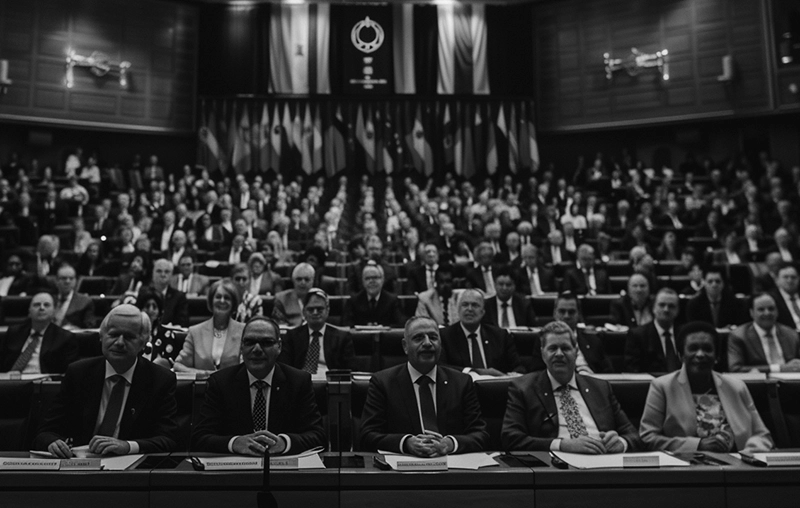In 1945, with the defeat of Japan, Korea was liberated, but the joy of liberation was short-lived. The Korean peninsula entered a new phase of political turmoil and foreign intervention, and the domestic political situation was extremely complex.
On the eve of Japan’s defeat, Yeo Un-hyeong took over from the Korean governorate and assumed the crucial responsibility of maintaining order in the country. Together with Ahn Jae-hong and others, he organized the “Preparatory Committee for the Establishment of the Republic of Korea,” which aimed to unite the forces of the left and right and establish an autonomous government after liberation.
The committee played an important role in maintaining social order by establishing 145 branches across the country, which were responsible for policing and administration. However, as the left-wing forces, including the Korean Communist Party, gradually gained control within the committee, Ahn Jae-hong rebelled and broke away from the committee, founding the Korean Nationalist Party.
Before the euphoria of liberation had worn off, the domestic political situation became more complicated. Upon learning of the American victory, the KPA reorganized its central organization into a governmental form and reorganized its branches into people’s committees to gain an advantage in negotiations with the American military government.
In the process, the establishment of the People’s Republic of Korea was proclaimed, and the KPA was dissolved. This led to an intensification of the confrontation between leftist and rightist forces on the Korean peninsula, and the rise of various political factions with different political ideologies and goals.
The right-wing forces included the “Korean Democratic Party” formed by Song Jin-woo and Kim Sung-soo, the “Central Council for the Promotion of Independence” led by Syngman Rhee, and the “Korean Independence Party” led by Kim Koo. The “Korean Democratic Party” expressed support for the Korean Provisional Government and worked closely with the US military government.
After returning from the United States, Syngman Rhee organized the Central Council for the Promotion of Independence to lead the independence movement, while Kim Gu returned to Korea as a private citizen, not as president of the Provisional Government, and worked with Provisional Government officials to form the Korean Independence Party.
The left-wing forces were led by Park Hyun-young, who formed the Workers’ Party of South Korea after liberation with a radical socialist ideology. Their goal was to build a socialist state, which made clashes with the right-wing forces inevitable.
The center-right, including Ahn Jae-hong, founded the Kookmin Party with a neo-nationalist agenda, while Yeo Un-hyŏng formed the Korean People’s Party after the dissolution of the People’s Republic of Korea and sought to establish his own position within the left-wing camp.
In December 1945, the world was in turmoil in the aftermath of World War II, and the foreign ministers of the United States, the United Kingdom, and the Soviet Union met in Moscow to discuss post-war affairs. One of the main issues on the agenda was the independence of the Korean peninsula.
As a result of the talks, it was decided to establish a provisional democratic government on the Korean peninsula and to establish a US-Soviet Joint Committee to support it. It was also agreed that the peninsula would be governed by a trusteeship of four countries – the US, the UK, the USSR, and China – for up to five years to ensure its security and development.
When the outcome of the Moscow Trilateral Conference was announced, there was a huge backlash in South Korea, especially when the decision on trusteeship was highlighted, right-wing forces, including Kim Gu, Syngman Rhee, and others, perceived it as another form of colonial rule and strongly opposed it.
The left-wing Korean Communist Party also initially opposed trusteeship, but later shifted its stance to support it when it realized that the Moscow Trilateral Conference’s decision focused on establishing an interim democratic government.
This intensified the pro-trust and anti-trust confrontation over trusteeship, and the conflict between the left and right gradually reached a serious level.
While the left supported the decision of the Moscow Trilateral Foreign Ministers’ Conference and advocated for independence through the establishment of a provisional government, the right fiercely opposed it and sought to preserve the cause of the independence movement.
In this process, the middle ground was gradually lost, and the confrontation between the left and right became more extreme. This confrontation eventually became the beginning of the North-South division and the seeds of the tragic conflict in Korea’s modern history.
The decisions of the Moscow Trilateral Foreign Ministers’ Conference were a key turning point in the fate of the Korean peninsula. The options for trusteeship and the establishment of a provisional democratic government sparked a great deal of conflict within Korean society, which would later lead to the division of the country into North and South Korea.
This reflects the chaotic political situation immediately after liberation and the complex political reality that Korea faced amidst foreign intervention.
Against this backdrop, we can gain a deeper understanding of the political turmoil of the immediate post-liberation period and the impact of the left-right divide on Korea’s modern history. The political situation in post-liberation Korea was not simply limited to internal issues, and it is important to look at how both the left and right responded to the international balance of power.
By understanding this historical context, we can learn lessons for resolving political and ideological conflicts in Korean society and moving toward a better future.

